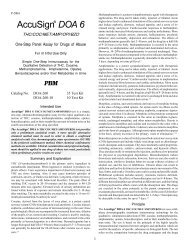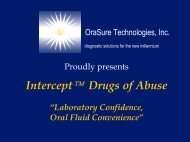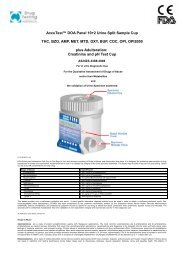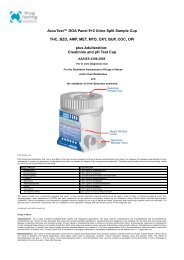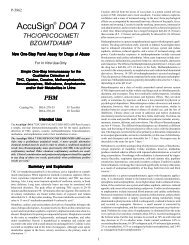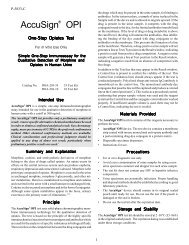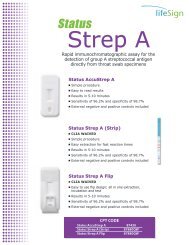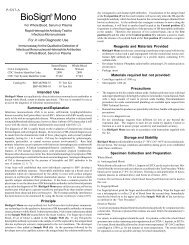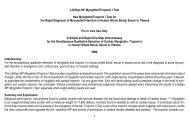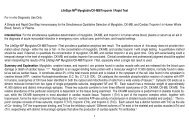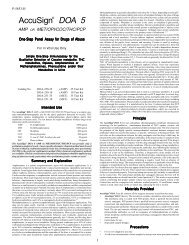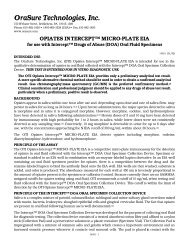AccuSign® BAR - Drug Test
AccuSign® BAR - Drug Test
AccuSign® BAR - Drug Test
You also want an ePaper? Increase the reach of your titles
YUMPU automatically turns print PDFs into web optimized ePapers that Google loves.
P-5845-DAccuSign ® <strong>BAR</strong>One-Step Barbiturates <strong>Test</strong>For In Vitro Use OnlySimple One-Step Immunoassay for theQualitative Detection of Barbiturates and/ortheir Metabolites in Human UrineCatalog No. DOA-206-35 35 <strong>Test</strong> KitDOA-206-10 10 <strong>Test</strong> KitIntended UseThe AccuSign ® <strong>BAR</strong> test is a simple, one-step, immunochromatographicassay for the rapid, qualitative detection of barbituratesand/or their metabolites in human urine with a cutoff at 300 ng/mLfor secobarbital.The AccuSign ® <strong>BAR</strong> test provides only a preliminary analyticalresult. A more specific alternative chemical method must be usedin order to obtain a confirmed analytical result. Gas chromatography,mass spectrometry (GC/MS) is the preferred confirmatorymethod. Other chemical confirmatory methods are available.Clinical consideration and professional judgment should beapplied to any drug of abuse test result, particularly whenpreliminary positive results are used. 1Summary and ExplanationBarbiturates are a group of chemicals derived from barbituric acid.Classified as hypnotics, they depress the central nervous system.Taken orally in pill or tablet form, they are prescribed for manymedical conditions, usually for their sedative effect. Abuse ofbarbiturates can, however, lead not only to impaired motor coordinationand mental disorder, but also to respiratory collapse, comaand death. The combination of barbiturates and alcohol is particularlydangerous.Symptoms of barbiturate abuse include drowsiness, slurred speechand irritability. Acute conditions include respiratory collapse andloss of consciousness. Chronic conditions include addiction, abstinence,seizures, and death. The effects of short-acting barbituratessuch as pentobarbital and secobarbital last 3 to 6 hours. The effectsof long-acting barbiturates such as phenobarbital last 10 to 20hours. Short-acting barbiturates normally remain detectable inurine for 4 to 6 days, while long-acting barbiturates can be detectedfor up to 30 days. Short-acting barbiturates are generally excretedas metabolites, while long-acting ones primarily appear unchanged. 1,2 1PrincipleThe AccuSign ® <strong>BAR</strong> test uses solid-phase chromatographic membraneimmunoassay technology for the qualitative detection ofbarbiturates. The test is based on the principle of the highly specificimmunochemical reactions between antigens and antibodies whichare used for the analysis of specific substances in biological fluids.The test relies on the competition between the drug conjugates andthe drugs which may be present in the urine sample, for binding toantibodies. In the test procedure, a sample of urine is placed in theSample well of the device and is allowed to migrate upward. If thedrug is present in the urine sample, it competes with the drugconjugate bound to the dye, for the limited antibodies immobilizedon the membrane. If the level of drug or drug metabolite is abovethe cutoff level, the drug will saturate the antibodies, thus inhibitingthe binding of the dye coated with drug conjugates to the antibodieson the membrane. This prevents the formation of a line on themembrane. Therefore, a drug-positive urine sample will not generatea line at the <strong>Test</strong> (T) position in the Result window, indicatinga positive result from positive drug competition. A negative urinesample will generate a line at the <strong>Test</strong> position in the Resultwindow, indicating a negative result from an absence of competitionwith free drugs.In addition to the line that may appear at the <strong>Test</strong> position in theResult window, a Control line must appear at the Control (C)validation position in the Result window to confirm the viability ofthe test. This Control line should always be seen if the test isconducted properly. This works as a procedural control, confirmingthat proper sample volume was used and the reagent systemworked. If insufficient sample volume is used, there may not be aControl line, indicating that the test is invalid.Materials ProvidedThe AccuSign ® <strong>BAR</strong> test kit contains all the reagents necessary toperform the assay.• AccuSign ® <strong>BAR</strong> device. The test device contains a membranecoated with monoclonal anti-barbiturate antibody and a padcontaining drug-dye conjugate in a protein matrix.• Disposable sample dispenser.• Instructions for use.Precautions• For in vitro diagnostic use only.• Avoid cross contamination of urine samples by using a newurine specimen container and dropper for each urine sample.• The test kit does not contain any HIV or hepatitis infectivecomponents.• Urine specimens are potentially infectious. Proper handlingand disposal methods should be established according to goodlaboratory practices.• The AccuSign ® <strong>BAR</strong> device should remain in its originalsealed pouch until ready for use. Do not use the test if the pouchis damaged or the seal is broken.• Do not use the test kit after the expiration date.Storage and StabilityThe AccuSign ® <strong>BAR</strong> test kit should be stored at 2–30°C (35–86°F)
Add 3 drops(110 µL)Read in3–10minutes<strong>BAR</strong>CTSORCONTROL (VALIDATION) LINE (C).The Control/Validation line indicates:1. If the proper amount of sample was used;2. If the sample wicked;3. If the procedure was followed properly.If no control line appears, the test is NOT VALID.Repeat the test using a new device, and follow theprocedure carefully.CTCTCTSTC<strong>BAR</strong><strong>BAR</strong> (–)<strong>BAR</strong> (–) <strong>BAR</strong> (+)Negative (–) = Control line and <strong>Test</strong> linePositive (+) = Control line only; No <strong>Test</strong> lineINVALIDin the original sealed pouch. The expiration dating was establishedunder these storage conditions.Specimen Collection and PreparationApproximately 110 µL of urine sample is required for each test.Fresh urine specimens do not require any special handling orpretreatment. Specimens should be collected in a clean glass orplastic container. If testing will not be performed immediately,specimens should be refrigerated (2–8°C) or frozen. Specimensshould be brought to room temperature before testing.Specimens containing a large amount of particulate matter maygive inconsistent test results. Such specimens should be clarifiedby centrifuging or allowing to settle before testing.<strong>Test</strong> ProcedureThe test procedure consists of adding the urine sample to theSample well of the device and watching for the appearance ofcolored lines in the result window.<strong>Test</strong> Protocol1. For each test, open one AccuSign ® <strong>BAR</strong> pouchand label the AccuSign ® <strong>BAR</strong> device with thepatient ID.2. Holding the dropper vertically, dispense 3 drops(110 µL) of the urine sample into the Samplewell (S).3. Read the result after 3 minutes, but within 10minutes of sample addition.Interpretation of ResultsNegative: The appearance of a reddish-purple Control line (C)and a line next to T indicates a negative test result; i.e., no drugabove the cutoff level has been detected. The color intensities of theControl line and the <strong>Test</strong> line may not be equal. Any faint line nextto T in the Result window, visible in 10 minutes, should beinterpreted as negative. A negative test result does not indicate theabsence of drug in the sample; it only indicates the sample does notcontain drug above the cutoff level in qualitative terms.Positive: The appearance of only a reddish-purple Control lineand no distinct line next to T indicates the test result is positive for<strong>BAR</strong> (i.e., the specimen contains <strong>BAR</strong> at a concentration above thecutoff level). A positive test result does not provide any indicationof the level of intoxication or urinary concentration of the drug inthe sample; it only indicates the sample contains drug above thecutoff level in qualitative terms.Invalid: A distinct Control line (C) should always appear. Thetest is invalid if no Control line forms at the C position. Such testsshould be repeated with a new AccuSign ® <strong>BAR</strong> test device.Limitations• The test is designed for use with unadulterated urine only.• There is a possibility that factors such as technical or proceduralerrors, as well as other substances in the urine samplewhich are not listed in Table 3 below, may interfere with thetest and cause erroneous results.• Adulterants, such as bleach and/or alum, in urine specimensmay produce erroneous results. If adulteration is suspected, thetest should be repeated with a new sample.• The test result read after 10 minutes may not be consistent withthe original reading obtained within the 10 minute readingperiod. The test must be read within 10 minutes of sampleapplication.• Certain medications containing barbiturates may produce apositive result.User Quality ControlInternal Control: Each AccuSign ® test device has built-in controls.The Control line is an internal positive procedural control. Adistinct reddish-purple Control line should always appear at the Cposition, if the test procedure is performed properly, an adequatesample volume is used, the sample and reagent are wicking on themembrane, and the test reagents at the control line and the conjugate-colorindicator are reactive. In addition, if the test has been
performed correctly and the device is working properly, the backgroundin the result window will become clear and provide adistinct result. This may be considered an internal negative proceduralcontrol.The positive and negative procedural controls contained in eachAccuSign ® test device satisfy the requirements of testing a positivecontrol and a negative control on a daily basis. If the Control linedoes not appear at the Control position, the test is invalid and a newtest should be performed. If the problem persists, contact PBM fortechnical assistance.External Control: External controls may also be used to assurethat the reagents are working properly and that the assay procedureis followed correctly. It is recommended that a control be tested atregular intervals as good laboratory testing practice. For informationon how to obtain controls, contact PBM’s Technical Services.Expected ValuesAccuSign ® <strong>BAR</strong> is a qualitative assay. The amount of barbituratesand/or their metabolites present in the urine cannot be estimated bythe assay. The assay results distinguish positive from negativesamples. Positive results indicate the samples contain barbituratesand/or their metabolites above the cutoff concentration.Performance CharacteristicsThe AccuSign ® <strong>BAR</strong> test has been shown to detect secobarbital ata cutoff of 300 ng/ml in urine. The test also detects other barbitalslisted below at the minimum concentrations indicated (Table 2).The accuracy of AccuSign ® <strong>BAR</strong> was evaluated in comparison toa commercially available immunoassay (Syva ® EMIT ® II). A totalof 248 samples was tested by both procedures. The overall accuracyof the test was 98.8%, as shown below (Table 1).Table 1. Accuracy: Comparison of AccuSign ® <strong>BAR</strong> withSyva ® EMIT ® IISyva ® EMIT ® II (<strong>BAR</strong>)Positive Negative TOTALAccuSign ® Positive 102 0 102<strong>BAR</strong> Negative 3 143 146TOTAL 105 143 248Relative Sensitivity Relative SpecificityAccuSign ® <strong>BAR</strong> 97.1% (102/105) > 99.9% (143/143)Discrepant samples for <strong>BAR</strong> were analyzed by GC/MS. The threefalse-negative samples contained the drug at 318, 304 and 306 ng/mL. In a separate study, AccuSign ® <strong>BAR</strong> was evaluated with 23specimens confirmed as positive by GC/MS. The range of drugvalues was 304 to 575 ng/mL. The results demonstrate the excellentcorrelation of AccuSign ® <strong>BAR</strong> with GC/MS.Precision and AccuracyThe precision of AccuSign ® <strong>BAR</strong> was determined by carrying outthe test with serially diluted standard drug solutions, using 3 lots ofproduct on 3 different dates. About 98% of the samples containingsecobarbital levels 25% over the cutoff level (i.e., 375 ng/mL)consistently showed positive results.Distribution of Random Error:Twenty (20) blind samples prepared by spiking various concentrationsof secobarbital were separately tested by two operators. Thetest results from the two operators showed complete agreement.ReproducibilityThe reproducibility of the test results of AccuSign ® <strong>BAR</strong> wasexamined at three different sites using a total of 15 blind controls,consisting of 5 negative samples, 5 moderately positive samples(600 ng/mL secobarbital), and 5 strongly positive samples (1,200ng/mL secobarbital). The results obtained at these three sites withthese controls demonstrated 100% agreement with each other.SpecificityCompounds that are detected by the AccuSign ® <strong>BAR</strong> test are listedbelow (Table 2). The specificity of AccuSign ® <strong>BAR</strong> was determinedby adding various drugs and drug metabolites to drugnegativeurine specimens and testing with the AccuSign ® <strong>BAR</strong> testkit. The results are expressed in terms of the concentration requiredto produce a positive result.Table 2. SpecificityConcentrationCompound(ng/mL)Allobarbital 500Alphenal 400Amobarbital 2,000Aprobarbital 200Barbital 1,500Butalbital 200Cyclopentobarbital 500Pentobarbital 1,000Phenobarbital 3,000Phenytoin 5,000Secobarbital 300Thiopental > 100,000The following compounds show no cross-reactivity when testedwith AccuSign ® <strong>BAR</strong> at a concentration of 100 µg/mL (Table 3).Table 3. Non Cross-Reacting CompoundsAcetaldehyde4-AcetamidophenolAcetoneAcetophenetidin(Phenacetin)N-AcetylprocainamideAcetylsalicylic acidAlbuminAminopyrineAmitryptylineAmoxapineAmoxicillinD,L-AmphetamineL-AmphetamineAmpicillinApomorphineAscorbic acidAspartameAtropineBenzilic acidBenzocaineBenzoic acidBenzoylecgonineBenzphetamineBilirubinCaffeineCalcium hypochlorideCannabidiolCannabinolChloralhydrateChloramphenicolChlordiazepoxideChlorothiazideChlorpheniramineChlorpromazineChlorquineCholesterolClomipramineClonidineCocaineCodeineCortisone(–) CotinineCreatinineDeoxycorticosteroneDextromethorphanDextropropoxypheneDiazepamDiclofenacDiethylpropionDiflunisalDigoxinDiphenhydramine3
DomperidoneDoxylamineEcgonineEcgonine methylester(+) Ephedrine(±) Ephedrine(–) Ephedrine(–) Ψ EphedrineEpinephrineErythromycinß-EstradiolEstriolEstrone-3-sulfateEthyl-p-aminobenzoateFenoprofenFuroxmideGentisic acidGuaiacol glyceroletherGlucoseGlucuronideGlutethimideGuaifenesinHemoglobinHippuric acidHydralazineHydrochlorothiazideHydrocodoneHydrocortisoneHydromorphoneO-Hydroxyhippuricacid3-HydroxytyramineIbuprofenImipramineIproniazid(–) IsoproterenolIsoxsuprineKetamineKetonesKetoprofenLabetalolLevorphanolLidocaineLoperamideLoxapine succinateLysergic aciddiethylamindeMaprotilineMelaninMeperidineMeprobamateMethadoneD-Methamphetaminep-HydroxymethamphetamineMethaqualoneMethoxyphenamine(±) 3,4-Methylenedioxyamphetamine(±) 3,4-MethylenedioxymethamphetamineMethylphenidateMethyprylonMorphineMorphine-3-ß-DglucuronideNalidixic acidNalorphineNaloxoneNaltrexoneNaproxenNiacinamideNifedipineNorcodeinNorethindroneNoroxymorphoneD-Norpropoxyphene(–) NorpseudoephedrineNoscapineNylidrinD,L-OctopamineOxalic acidOxazepamOxolinic acidOxycodoneOxymetazolineOxymorphonePapaverinePenicillin-GPentazocainePerphenazinePhencyclidinePhendimetrazinePhenelzineß-PhenethylaminePhenothiazinePhenterminePhenylbutazoneL-PhenylephrineD-PhenylpropanolaminePrednisolonePrednisoneProcainePromazinePromethazineD,L-PropanololPropiomazineD-PropoxypheneD-PseudoephedrineL-PseudoephedrineQuinidineQuinineRantidineSalicylic acidSerotoninSodium chlorideSulfamethazineSulindacTemazepamTetracyclineTetrahydrocortisoneTetrahydrozoline∆ 8 -THC∆ 9 -THC11-nor-∆ 9 -THC-9-COOHThebaineThiamineThioridazineD,L-ThyroxineTolbutamideTriamtereneTrifluoperazineTrimethoprimTrimipramineTryptamineD,L-TryptophanTyramineD,L-TyrosineUric acidVerapamilZomepiracReferences1. Hawks RL, Chiang CN, eds. Urine <strong>Test</strong>ing for <strong>Drug</strong>s of Abuse.Rockville, MD: National Institute on <strong>Drug</strong> Abuse (NIDA), ResearchMonograph 73;1986.2. Baselt RC. Disposition of Toxic <strong>Drug</strong>s and Chemicals in Man.2nd Ed., Davis, CA: Biomedical Publ.;1982;p.488.Symbols KeyManufactured byCE MarkAuthorized RepresentativeIn Vitro Diagnostic Medical DeviceCatalog NumberConsult Instructions for UseBatch Code“Use By” date in year-month-day formatTemperature LimitationContains sufficient for testsDo not reuseContents<strong>Test</strong> DeviceTransfer PipetteInstructions for UseOne-step immunochromatographic Assay forthe Detection of <strong>Drug</strong>s of Abuse in UrineBarbiturates <strong>Test</strong>AccuSign ® is a Registered Trademark of Princeton BioMeditech Corporation.Manufactured byPatent No.: 5,559,041© 2000 PBMPrinted in U.S.A.Revised Oct 2003P-5845-D 1001BLMT Promedt Consulting GmbHEisenbahnstrasse 2D-66386 St. IngbertGermany+49-68 94-58 10 20Princeton BioMeditech CorporationPrinceton, NJ 08543-7139 U.S.A.1-732-274–1000 www.pbmc.com4



